Iguanas (Land, Marine and Tropidurid)
The first of two iguana photo albums contain three galleries of iguanas, placed in Order Squamata, that I photographed in their natural habitats. The first displays images of land iguanas. The second features marine iguanas and the final gallery shows photos of Galápagos tropidurid iguanas. See Taxonomy note at the end of this page.
Iguanas (Land)
Land Iguana Notes
The three endemic Galápagos land iguanas are ‘Red List 2020’ assessed as ‘Vulnerable’.
I photographed the two yellowish coloured species: Conolophus subcristatus, native to Fernandina, Isabela, Santa Cruz, adjacent smaller islands; and Conolophus pallidus found only on Santa Fé. A third species, the pink or Rosada iguana inhabits Wolf Volcano on Isabela Island, which tourists cannot access.
The images show portraits, closeups, and behaviours of these land iguanas.
Iguanas (Marine)
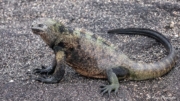
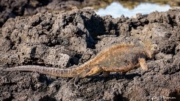
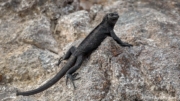
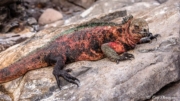
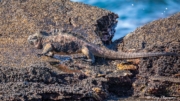
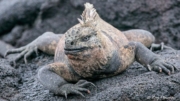
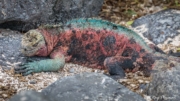
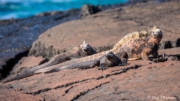
Marine Iguana Notes
Galápagos marine iguanas are endemic species ‘Red List 2020’ assessed as ‘Vulnerable’. Traditionally there are seven recognised subspecies of Marine Iguana (Amblyrhynchus cristatus). In 2017 the Zoological Journal published a genetic and morphological review which proposed introducing five new subspecies. I follow this proposed list of elven subspecies.
The photos show selected portraits, closeups, and behaviours of male, female and young iguanas.
The first seven images are the nominate species Amblyrhynchus cristatus photographed on Isabella and Fernandina Islands. A. c. formerly known as A. c. albemarlensis on Isabella Island. The remaining Galápagos Marine Iguana images include four subspecies: A. c. hassi on Santa Cruz, A. c. nanus on Genovesa, A. c. venustissimus on Española, and A. c. wikelskii (formerly A. c. mertensi) on Santiago and Rabida.
The other six subspecies inhabit islands that are not accessible or have limited access by tourists.
Galápagos marine iguanas exhibit strong sexual size dimorphism. Subspecies have a large difference in body mass with males being about twice as heavy as females.
The first image shows a marine iguana mess and the second a fight between two males observed by several females. Males do not usually bite each other but instead thrust their heads together to push each other away. I photographed the fight for over five minutes, but these fights can last for hours, interrupted by short breaks. The other photos show closeups and portraits of five subspecies I encountered. Two subspecies are distinctively coloured: the diminutive black A. c. nanus on Genovesa and the larger bright red/blue A. c. venustissimus on Española.
Iguanas (Tropidurids)
Tropidurid Iguana Notes
The Floreana Lava Lizard is ‘Red List 2020’ assessed as ‘Near Threatened’ while all other featured lava lizards are ‘Least Concern’; except for the Santa Fé lava lizard has no assessment.
Distribution of the Tropiduridae family (Tropidurids) is throughout South America, West Indies and the Galápagos Islands. The gallery displays six endemic Galápagos species. Tradition taxonomy recognises seven different species of lava lizards (genus Microlophus). However, recent research suggests there are nine or ten species. I have included photos of the following six species:
(a) Galápagos Lava Lizard (Microlophus albemarlensis),
(b) Española Lava Lizard (Microlophus delanonis),
(c) Floreana Lava Lizard (Microlophus grayii),
(d) Santa Cruz Lava Lizard (Microlophus indefatigabilis),
(e) Santiago Lava Lizard (Microlophus jacobi),
(f) Santa Fe Lava Lizard (Microlophus barringtonensis) as listed in the Reptile Database.
Distribution of the other four lava lizard species is on San Cristóbal Island and the three non-tourist accessible islands of Marchena, Pinzón and Pinta.
The images show male lizards and females when I have photographed them. I have also included two Santiago lava lizard photos, which shows slightly different skin patterns and colouration.
Iguana (Land, Marine and Tropidurid) Taxonomy
The Reptiles Photo Album webpage describes the higher-level taxonomy for the featured families placed in suborder Iguania, order Squamata (Lizards, Skinks, Snakes).
The Iguanidae (Iguanas) family contains three subfamilies, including Iguaninae. The Land and Marine Iguanas galleries display photos from the two endemic Galápagos genera.
Tropidurid Lizards feature images from the only subfamily Tropidurinae placed in the Tropiduridae family.























